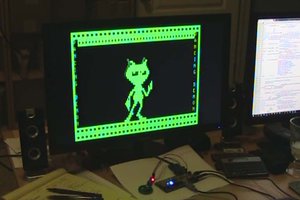When microcomputers first appeared there was, of course, precious little software available for them. If you wanted to use a microcomputer for some particular purpose you were probably going to have to write the software yourself. That was the position I was in more than forty years ago with my first computer, an Explorer 85 from Netronics Research. My long-term goal had been to expand the system enough to eventually use CP/M, which was becoming the most popular OS for 8 bit computers, and for which there was a rapidly expanding wealth of software. During that time I was involved in deploying systems for the company I worked for that included magnetic bubble memory. When I learned that Intel was selling bubble memory evaluation kits I decided to use one of those for non-volatile storage instead of a more expensive 8 inch floppy drive. In preparation for building a floppy drive interface card, I had already purchased a copy of the book "K2FDOS, A Floppy Disk Operating System For the 8080" by Kenneth B. Welles (CP/M would have been a later upgrade). It took a lot of hours, but I eventually had K2FDOS working on my system, along with an editor/assembler from another book: "TEA, An 8080/8085 Co-Resident Editor/Assembler" by Christopher A. Titus. I also had another assembler that I had written from scratch that could assemble source code split into multiple files (RAM was expensive). I used that system for a long time, eventually replacing it with something newer, but I never actually got rid of it.
Explorer 85:

Last summer I discovered the SBC-85 project here, and decided to build one, thinking that perhaps I could get the software I had been using forty years ago to run on that hardware. The first thing to do was to build the SBC-85 system, including the CPU board, Memory Expansion board, Backplane, and the Bubble Memory board. I also built the Bus Monitor for good measure. It's a very nice system, but not all that useful without software, although it does have a very capable monitor program.
SBC-85 with Bubble Memory and Bus Monitor

The next step was to try to recover as much software as possible from the old Explorer. In the end I was reasonably successful with both the bubble memory and cassette tapes. Now began the final stage of this project: getting that software to work on the SBC-85. K2FDOS is actually five separate programs: Boot, Sysgen, Format, PIP, and FDOS. The boot program reads an executable copy of FDOS into RAM. The sysgen program basically does the opposite: it saves the copy of FDOS that's in RAM. The format program prepares the storage media, whatever it is, for use by FDOS. PIP is an auxiliary program for FDOS that provides a user interface to perform common tasks like renaming, deleting, listing files, etc. And FDOS itself provides all the basic file and I/O functions that external programs might need.
Although I could find the source for most of the software I was interested in, the only source files I could find for FDOS itself were very early copies that didn't include any of the changes necessary to get it to work with bubble memory. However, I did have the executable and a printout that was nearly the same as the executable, so I used DASMx to disassemble the executable, resulting in a source file that assembled to a binary that matched the executable from the Explorer. For a cross assembler I use AS (or ASL on FreeBSD). It still took some effort to get that version of FDOS working on the SBC-85. For one thing, I had been using a parallel port on the Explorer as console in, whereas the SBC-85 uses the processor's SID pin. There were also a number of places in the source that didn't look quite right. Mostly cases where there were pointers referencing locations that didn't seem to make any sense. I had to go through all of those and...
Read more » Denver
Denver



 f4hdk
f4hdk
 Andy
Andy
 ziggurat29
ziggurat29
 cprossu
cprossu
Punching a punching bag can be a part of an can you lose weight by punching a punching bag</a> overall fitness routine that may contribute to weight loss, but it is not a guaranteed method to lose weight on its own. https://www.fitsyology.com/does-punching-bag-burn-fat/